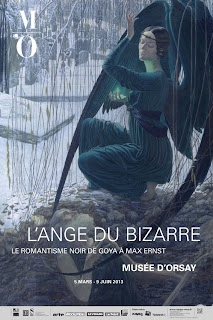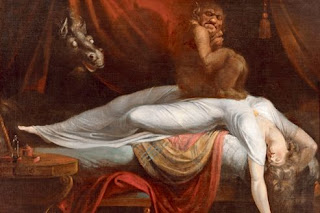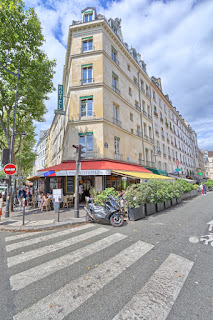"L'Ange Du Bizarre" jette une ombre sur le Musée D'Orsay... "The Angel of the Odd" is at Orsay Museum...
Né dans un roman du XVIIIème siècle, le romantisme noir a très vite gagné l'art pictural. L'accès à un imaginaire aéré et sans limite, libère le peintre comme le spectateur, d'une situation économique et politique souvent rude et décevante. L'invitation à l'évasion dans un univers noir et incertain, plaît. Les châteaux froids et secrets, les forêts vastes et denses...des cadres propices à l'inspiration. L'artiste explore le possible et l'insurmontable. L'irréel surgit de manière imposante dans une réalité bien trop sage. Quand la mythologie faisait rêver les mécènes d'hier, l'inconscient réagit en peinture aujourd'hui. Le peintre fait appel aux secrets inavoués, aux vices et intentions cachées. En dévorant la toile, le visiteur fait une introspection. L'âme n'est pas monochrome. Chacun ressent en lui la piqure d'une rose noire, cette gangrène qu'il tente de dissimuler dans ses rêves. Et face à cette intimité dévoilée, la raison n'a plus sa place dans la pièce. Il est comme permis de penser à mal, d'oser le vil. Les peintures jouent la violence, les actes sont tribaux, barbares. Le cannibalisme est un sujet récurrent, représentation quasi irréprochable de l'extrémisme du genre humain. La passion dévorante, l'avidité du pouvoir,...
Les plaisirs interdits hantent aussi les pièces du musée. Entre le mal et le bon, une frontière de charme. La scène du Cauchemar de Fussli, met en avant une jument folle et un incube gothique violentant une jeune vierge. Mais il émane du tableau une jouissance paralysante. Les repères se dissolvent entre la bienséance et la véracité émotionnelle. Quand la psychanalyse s'interroge, le romantisme noir illustre la nature de l'homme. Levant ainsi le voile sur ses peurs, le visiteur est face à ce qu'il enfouit depuis toujours. La hantise de la mort, de l'inconnu, de la folie. Perdu dans les méandres de ses sentiments, l'homme doit accepter, se résigner. Il est ainsi qu'il est complexe. Dans l'inconnu et l'imaginaire, les sorcières, démons et vampires apparaissent en maîtres sur les toiles. Ils règnent sur un monde qui n'a plus de chemin tracé vers le bien et la logique. Nul besoin de peindre un monde qui n'existera jamais, les champs de blés font place à l'enfer et son monde privé de ciel. Les paysages deviennent lourds et étouffants, le tableau enferme et ne libère plus l'esprit. Il condamne. Entrez et vous ne sortirez plus. Les personnages comme Satan prennent des allures de héros quand celui qui occupait cette place jadis en devient la victime. Les jeunes vierges sont le sujet idéal pour des massacres ou enlèvements. Puis la femme change de rôle vers la fin du XIXème siècle. Ainsi les anti-héros deviennent Méduse, Salomé ou le Sphinx... La femme fatale engendre nombre de créations. Elle effraie, séduit, irrite. La femme en objet de convoitise est la représentation du mal dans toute sa perversité.
Au début du XXème siècle, le surréalisme s'intéresse au romantisme noir. Désireux d'exprimer leurs idées sur la première guerre mondiale, les surréalistes apprécient le courant pour sa faculté à réfuter les normes et à intégrer l'imaginaire dans sa révolte. Le romantisme noir compte parmi ses adeptes des peintres mais également des photographes et des cinéastes. Mais c'est à présent dans un cadre réaliste que composent la folie et la fantaisie. Les romans continuent à fournir de la matière et l'imagination des artistes, n'ayant de limite que dans leur propre créativité, fait le reste. Le romantisme noir séduit les artistes par l'étendue des possibilités qu'il offre. La mélancolie, la peur, la souffrance, sont des thèmes si vastes que l'imaginaire ne saurait un jour en refermer les portes.
Ouvert tous les jours sauf le lundi.
 |
| Le Péché, Franz von Stuck. |
*****
Since March 5, a special atmosphere runs through the large rooms of the Musée D'Orsay. A dark and impertinent veil covers the visitor entering with a morbid curiosity. As a call from the depths of the soul to the man's reason. The exhibition "The Angel of the Odd" intrigues and seduces by the discovery of dark romanticism. This current, which has survived the centuries and borders, is represented here through paintings but also through extracts films.
Born in a novel of the eighteenth century, the dark romanticism quickly gained pictorial art. The access to an airy and limitless imaginary, frees the artist and the viewer, from a rude and disappointing political situation. As an invitation to escape into a dark and uncertain world. Cold and secret castles, vast and dense forests ... those frameworks are conducive to inspiration. The artist explores the possible and the insurmountable. The unreal arises in a far too wise reality. When sponsors dreamed of mythology yesterday, painting represents unconscious today. The painter uses the unspoken secrets, vices and bad intentions. Looking at the canvas, the visitor makes an introspection. The soul is not monochrome. Everyone feels within himself the sting of a black rose, the gangrene that tries to escape in the dreams. And face to an intimacy revealed, the reason has no place in the room. It is possible to think of something bad. The paintings play with violence, acts are tribal, barbarians. Cannibalism is a recurring theme, almost a flawless representation of mankind extremism. Consuming passion, greed of power ...
The forbidden pleasures also haunt parts of the museum. Between evil and good, a tiny border. The scene of Nightmare (Fussli), highlights a mare and a crazy Gothic character doing violence to a young virgin. But it comes from it, a paralyzing enjoyment. Benchmarks dissolve between propriety and emotion. When psychoanalysis is questioning, dark romanticism illustrates the human nature. Thereby lifting the veil on his fears, the visitor is faced with what he buried since ever. The fear of death, of unknown, of madness. Lost in the meanderings of his feelings, man must accept that he is complex. Into the unknown and imagination, witches, demons and vampires appear on master paintings. They reign over a world that has no way to track the well and the logic. No need to paint a world that will never exist, the wheat fields give way to hell and a world with no sky. Landscapes become heavy and stifling. paints lock and do not release the spirit anymore. It condemns. Enter and you will never go out. Characters like Satan become heroes when former heroes become victims. The young virgins are the ideal subject for killings or kidnappings. Then the woman changed of role in the late nineteenth century. And anti-heroes become Medusa, the Sphinx and Salome ... The Fatal Woman causes many creations. She scares, seduces, irritates. The woman as an object of desire, is the evil representation in all its perversity.
In the early twentieth century, Surrealism is interested in dark romanticism. Wishing to express their ideas about the First World War, the Surrealists like this current for its ability to refute standards and for incorporating imagination. Followers of dark romanticism are painters but also photographers and filmmakers. But it is now in a realistic setting that madness and fantasy can play. The novels continue to provide material and the imagination of artists do the rest. The dark romanticism seduces many artists with its range of possibilities. Melancholy, fear, suffering, are subjects loved by imagination. That is why dark romanticism will never die...
Open every day except Monday.
 |
| The Doll (head and knife), Hans Bellmer. |



.jpg)






